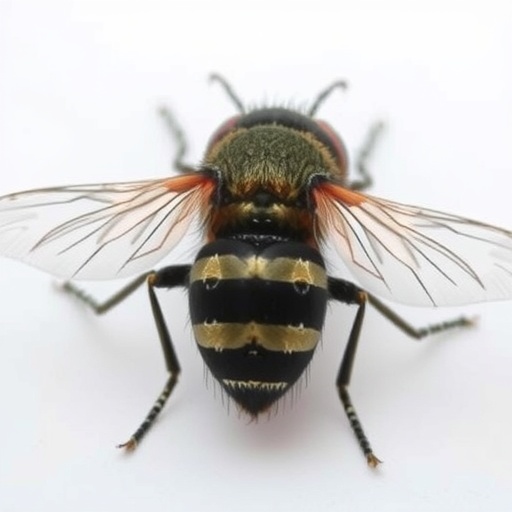In a groundbreaking study, researchers have delved into the population dynamics, gene flow, and genetic diversity of the Australasian sheep blowfly, scientifically known as Lucilia cuprina dorsalis. This species has gained significant attention due to its role as a major pest in the sheep farming industry, responsible for considerable economic losses and welfare issues in livestock due to myiasis, or flystrike. The research undertaken by Kapoor et al. represents a substantial contribution to our understanding of this pest’s genetics and its implications for agricultural management.
The study is particularly relevant given the challenges faced in sheep farming, where blowflies pose a consistent threat to animal health and farm profitability. As climate change modifies environmental conditions and pest behaviors, understanding the genetic structure of pest populations becomes crucial. This research identifies how genetic diversity and gene flow within Lucilia cuprina dorsalis populations can impact their adaptability and distribution across the Australian landscape.
Applying advanced genomic techniques, the researchers meticulously analyzed samples from diverse geographical regions in Australia. Collecting specimens across varied landscapes allowed the team to assess the genetic variation within populations, providing insight into the evolutionary history and migration patterns of the blowfly. The findings highlight how environmental factors and human activities interact to shape genetic diversity, a crucial element for the pest’s survival and adaptation.
In a world increasingly aware of the implications of biodiversity loss, this research underscores the importance of genetic variation for pest resilience. The team discovered that high levels of genetic diversity among Lucilia cuprina dorsalis populations could enhance their adaptive capabilities to changing environments. This adaptability could complicate management strategies aimed at controlling fly populations, making the findings particularly relevant for farmers and entomologists alike.
Moreover, the study examines the gene flow between different populations, revealing patterns that suggest significant movement and mixing among groups of blowflies. Such information is critical for predicting how genetic traits, which might confer advantages like insecticide resistance, can spread across regions. It raises vital questions about the effectiveness of current pest management strategies and highlights the need to develop integrated approaches that consider genetic factors.
Furthermore, this investigation into the genetic landscape of the sheep blowfly may have applications beyond agriculture. The frameworks and methodologies used to study Lucilia cuprina dorsalis can be extended to other pest species. By adopting a comprehensive genetic approach, researchers could develop better-targeted control measures and anticipate the effects of environmental changes on pest populations more effectively.
Traditional methods of managing blowfly populations have often relied on chemical interventions, which can lead to the development of resistance and environmental harm. The insights gained from understanding the genetic structure and behavior of Lucilia cuprina dorsalis can inform the creation of more sustainable pest control methods. Strategies that emphasize cultural practices, biological controls, or genetically-targeted interventions could arise from the findings of this research.
The implications of this study also extend to policy-making and farm management practices across Australia. Decision-makers can leverage this vital information to develop guidelines that mitigate the impacts of blowfly infestations while promoting sustainable farming practices. By prioritizing genetic research, the agricultural sector can enhance its resilience against future challenges posed by pests.
Notably, the research led by Kapoor and colleagues opens avenues for further studies that explore the intricacies of pest genetics in relation to climate change. As the global climate continues to evolve, understanding the biological factors that govern pest behaviors will be essential for effective agricultural policies and practices. This reinforces the need for collaborative efforts among scientists, farmers, and policymakers to tackle the complexities of pest management in a changing world.
In summary, Kapoor et al.’s study offers profound insights into the population structure, gene flow, and genetic diversity of Lucilia cuprina dorsalis. Their research not only enhances our understanding of this species but also provides vital information for developing future pest management strategies. By incorporating genetic considerations into agricultural practices, we can better equip ourselves to handle the challenges posed by pest species, ensuring a more sustainable and productive future for livestock farming.
This pivotal research serves as a reminder of the intricate interplay between genetics, environment, and agriculture. It encourages us to rethink our approach to managing pests and to consider the broader ecological impacts of our interventions. With continued investigations into the genetic dynamics of pest populations, we can pave the way for innovative solutions that protect both farmers and the wellbeing of their livestock.
As the landscape of agricultural science evolves, the findings presented in this study will likely shape the future of pest management, illustrating the essential role that genetic research plays in addressing contemporary challenges in agriculture. By embracing the knowledge gained from such studies, the farming community can work towards more effective and sustainable methods of safeguarding their livestock against the relentless threat posed by pests like the sheep blowfly.
Subject of Research: Population structure, gene flow, and genetic diversity of Lucilia cuprina dorsalis (sheep blowfly) in Australia.
Article Title: Population structure, gene flow and genetic diversity of sheep blowfly (Lucilia cuprina dorsalis) in Australia.
Article References:
Kapoor, S., Young, N.D., Jex, A.R. et al. Population structure, gene flow and genetic diversity of sheep blowfly (Lucilia cuprina dorsalis) in Australia.
BMC Genomics 26, 743 (2025). https://doi.org/10.1186/s12864-025-11852-y
Image Credits: AI Generated
DOI: 10.1186/s12864-025-11852-y
Keywords: Lucilia cuprina dorsalis, genetic diversity, gene flow, pest management, agriculture, climate change, Australian sheep industry.
Tags: advanced genomic techniques in pest researchagricultural management of livestock pestseconomic losses from flystrike in sheepevolutionary history of blowflies in Australiagene flow in pest populationsgenetic diversity of Lucilia cuprina dorsalisgeographical variation in blowfly populationsimpact of climate change on blowfliesimplications for animal health in sheep farmingmyiasis and its effects on livestock welfarepest management strategies for sheep farmingpopulation dynamics of sheep blowfly





